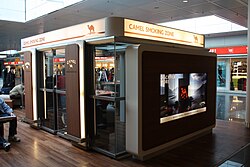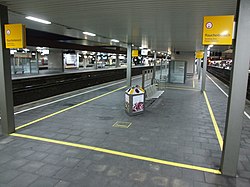This article needs to be updated. The reason given is: Much of the prevalence and statistical data is from 2013 or earlier. More recent data from sources like the DEBRA study is available..(August 2025) |

In Germany, smoking is widespread and is subject to very few and lax regulations compared to other European countries. [1] [2] [3] Tobacco taxes in Germany are among the lowest in Europe. [4] Germany ranks last on the Tobacco Control Scale [5] and has sometimes been referred to as the "smoker's paradise" of Europe. [6] [5] According to German addiction researcher Heino Stöver , Germany has "[...] more cigarette vending machines than any other country in the world." [7]
Contents
- Prevalence
- Cigarette smoking among adults, 2013
- Annual cigarette consumption per capita
- Cigarette consumption per day
- Tobacco consumption from 1991 until 2013
- Political measures against smoking
- Misleading labels
- Advertising
- Warning labels
- Tobacco taxation
- Sale restrictions
- Federal smoking ban
- Smoking ban by state
- Baden-Württemberg
- Bavaria
- Berlin
- Brandenburg
- Bremen
- Hamburg
- Hesse
- Lower Saxony
- Mecklenburg-Vorpommern
- North Rhine-Westphalia
- Rhineland-Palatinate
- Saarland
- Saxony
- Saxony-Anhalt
- Schleswig-Holstein
- Thuringia
- See also
- References
- Further reading
Under federal law, the manufacture, import, distribution, and advertisement of tobacco is regulated, while the 16 federal states of Germany each have their own legislation regarding smoking in public places, [8] which range from relatively weak regulations to full smoking bans in all licensed premises, childcare facilities, schools and governmental institutions.
As of 2024, nearly 40% of the German population live in the three states which ban smoking in all restaurants, pubs, cafés and nightclubs (Bavaria, North Rhine-Westphalia, and Saarland). The other 13 states permit smoking in designated rooms or in bars with a floor area of less than 75 square meters.
According to a 2013 micro-census survey, 24.5% of the German population aged fifteen years and over are smokers (29% of men, 20% of women). [9] Among the 18–25 age group, 35.2% are smokers. [10]










